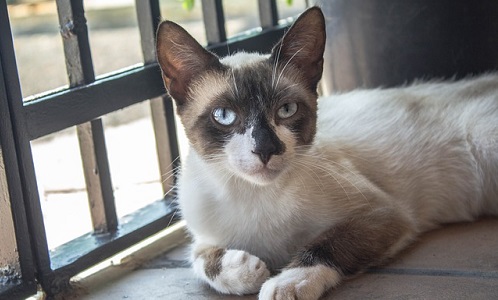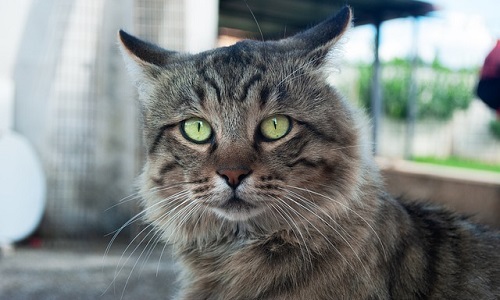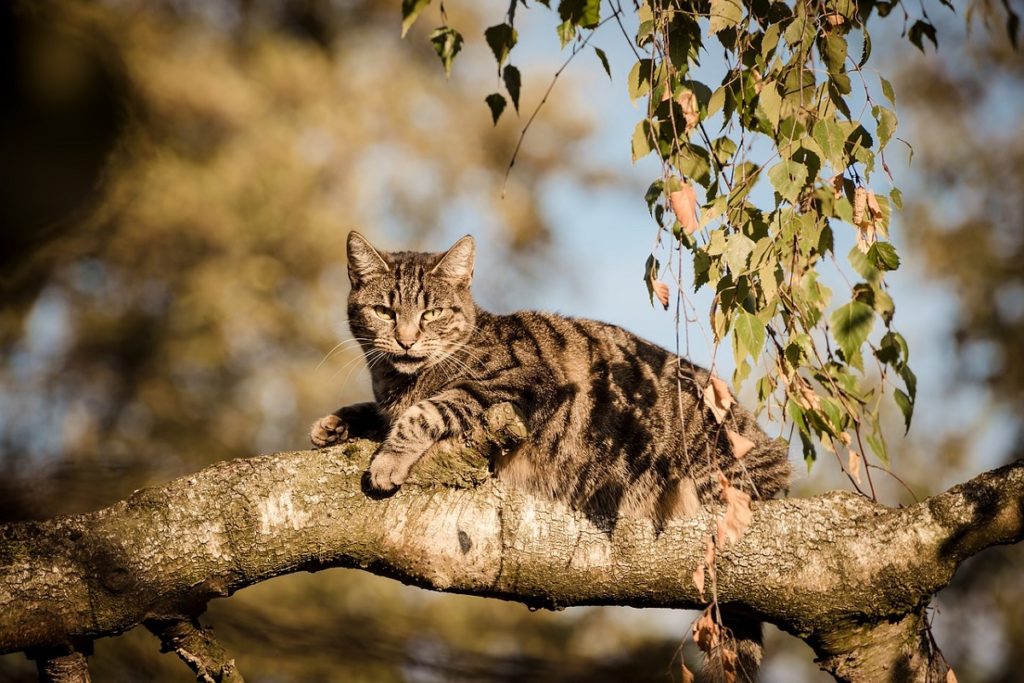If you are a cat owner, chances are you’ve already given up on having any real plants or flowers in your home, or perhaps you’ve become very creative with where you place your plants – after all, is there any place a cat can’t reach? Better yet, you may have given up on the green thumb hobby altogether and found some faux plants that look just as pretty as the real thing!
All too often, cats will not be deterred, it seems, from climbing Christmas trees, digging in the dirt of your houseplants, or munching on their leaves and stems. This goes for plants and flowers that are located inside and outside of the home. Cat owners that want to protect their furry felines (and bank accounts) from unnecessary trips to the vet can benefit from learning about the most common flowers and plants poisonous to cats.
When it comes to studying the topic of plants and cats, ‘poisonous’ and ‘toxic’ are phrases often used interchangeably. Some poisonous plants irritate the skin, mouth or stomach of a cat. However, other poisonous plants may damage their organs, induce seizures, or worse. Therefore, it’s good pet parenting to know which plants have the potential to do the most damage to your cat, especially if your feline spends any time outdoors, or goes to stay with a cat sitter whenever you’re out of town.
Why Do Cats Eat Plants?
 If plants have the potential to make cats get sick or die, then why do they eat them in the first place? In the wild, cats eat plants that aid in digestion or help them remove hairballs and undigested food from their stomachs. Most cat owners know that grass is a feline favorite for assisting with hairball regurgitation.
If plants have the potential to make cats get sick or die, then why do they eat them in the first place? In the wild, cats eat plants that aid in digestion or help them remove hairballs and undigested food from their stomachs. Most cat owners know that grass is a feline favorite for assisting with hairball regurgitation.
Cats, like humans, also use plants medicinally. Different plants help them to combat viral, bacterial, or parasitic infections they may contract living in the wild or at home. Like humans and fast food, many cats will choose the plant that can help them the most first, but, if they have nothing healthy to nibble on, they likely will munch on whatever is in reach.
Did You Know…
Good News, Bad News: The bad news first: according to the ASPCA, there are 417 plants and flowers that are toxic to cats – a very large statistic for a cat owner to contemplate. The good news: the organization’s comprehensive list, which includes photos of each plant, is available here. Cat owners that want to be as thorough as possible can study the list to ensure their cat’s safety. Before bringing home any green decor, make sure you double check and buy a household plant safe for cats.
Indoor Plants Toxic To Cats: A Helpful Guide
It might take a while to memorize 417 plants(!), so cat owners can get a running start by reading through this alphabetical checklist of 18 common plants and flowers that are commonly found in the home. These plants are particularly poisonous to your cat and, if ingested, will make any feline sick miserable or very sick indeed:
- Agave: Calcium oxalate plants such as agave – along with Chinese evergreens, philodendrons, rhubarb, spinach, taro and tea leaves (see below) – all possess needle-like barbs on their stems and leaves. Chewing on these plants can irritate a cat’s mouth and gums. In turn, ingestion of such plants can lead to drooling, feline vomiting and possible respiratory distress. Keep a watchful eye over your cat for at least two days after he eats any calcium oxalate plant on the list or any plant that looks like one of these plants, and if you notice any type of reaction whatsoever, contact your veterinarian immediately.
- Aloe Vera: A very common household plant, people use aloe vera to soothe sunburns; it has also become a popular ingredient in health drinks as well. While it is very beneficial for people, this plant is very unhealthy (and unpleasant) for your cat. Symptoms include vomiting, depression, feline diarrhea, and seizures in cats, as well as a change in urine color. In the event of accidental ingestion, it’s best to bring your cat to the vet before symptoms worsen.
- Autumn Crocus: Eating any part of the crocus will result in instant physical harm to your cat, and requires immediate attention. It burns the mouth and leads to diarrhea, seizure, organ damage and irregular heartbeats in cats. Go to the vet as soon as possible if your cat munches on this greenery.
- Chinese Evergreens: (see Agave)
- Daffodils: Commonly found both indoors and outdoors, these beautiful springtime favorites pose a serious danger to your cat. Ingestion of any part of a daffodil can cause severe distress in your cat, including vomiting, diarrhea, abdominal pain, heart palpitations, convulsions and a steep drop in his blood pressure. Get to the vet as quickly as possible if your cat consumes any daffodils.
- Dracaena Plants: Typically not fatal to your cat, these leafy household plants come in about 40 different varieties. If your cat nibbles on the fronds, he can become depressed, experience a loss of appetite, and your cat may vomit blood over a 24-hour period. If symptoms worsen, head to the vet to ensure things do not progress any further.
- Ivy: All forms of ivy are hazardous to your pet. More commonly found outside, a cat that has ingested ivy will show signs of gastrointestinal distress including vomiting, abdominal pain, drooling and diarrhea.
- Kalanchoe/Mother-In-Law Plant: This plant is commonly found indoors, and is frequently covered with densely-packed flowers. While they’re attractive for humans, they’re often tempting to cats. If your cat eats any kalanchoe, expect to see some vomiting and diarrhea. Heart issues are rare, but they’re possible, so bring your cat to the vet to determine if your pet is suffering any heart irregularities.
- Lilies: Pretty for Easter or springtime festivities, lilies of all varieties can be lethal to felines. Ingestion of any part of a lily can lead to lethargy, vomiting or kidney failure. The pollen alone can also be deadly for a cat.
- Philodendrons: (see Agave)
- Rhododendrons: (see Agave)
- Rhubarb: (see Agave)
- Sago Palm/Coontie Palm: Sago palms are everywhere. Many plants do not contain warning labels of their intense toxicity to cats and dogs. While they may be great for gifts or sprucing up the office, these palms, which are found both indoors and outdoors, are definitely trouble waiting to happen for your feline. As owners who have lost pets to these little trees will likely advise, clear them out of the house immediately. The chunky and sometimes colorful seeds and seed pods of this leafy tree-like plant are the most toxic to your cat. However, nibbles of any part of the plant can lead to gastrointestinal issues, bleeding disorders, liver failure and death. Take your cat to the vet as soon as you can if you have reason to believe he has ingested any sago or coontie palms.
- Spinach: Although spinach may be an excellent way to introduce greens into your cat’s diet, owners beware: cats with urinary or kidney problems (especially older cats with kidney disease) should avoid eating spinach, as it contains calcium oxalates which can lead to the formation of crystals within the urinary tract. Speak with your vet for dietary recommendations and questions regarding your pet’s nutrition.
- Taro: (See Agave)
- Tea Leaves: (see Agave)
- Tulips: Another springtime favorite, Tulips are best kept out of the house and yard if you are a cat owner. These pretty flowers, especially their bulbs, can cause irritation to the mouth including miserable bouts of drooling and nausea.
- Virginia Creepers: ( see Agave)
Outside Plants That Are Poisonous To Cats: What To Avoid
 While there already appears to be more than enough potential for trouble inside the home, cat owners must also be aware of the dangers of outside plants, which is of particular importance to outdoor cats. Unfortunately, there are a variety of outside plants, weeds, fungi, fruit trees and other vegetation that has the potential to make outdoor cats become seriously ill. Some of the most dangerous outdoor plants include:
While there already appears to be more than enough potential for trouble inside the home, cat owners must also be aware of the dangers of outside plants, which is of particular importance to outdoor cats. Unfortunately, there are a variety of outside plants, weeds, fungi, fruit trees and other vegetation that has the potential to make outdoor cats become seriously ill. Some of the most dangerous outdoor plants include:
- Buttercup
- Castor Beans
- Crocus
- Foxglove
- Hyacinth
- Jasmine
- Locoweed
- Lupine
- Mushrooms
- Rhubarb
- Spinach
Toxic trees include:
- Apricot,
- Almond
- Horse Chestnut
- Peach
- Cherry
- Rain Tree
Ingestion of even a small amount of toxic plants is serious – therefore, if your cat gets into any of the plants discussed above and ingests any part of them, it is in your furry friend’s best interest that you contact your veterinarian right away. Even if your cat isn’t showing any symptoms, call anyway to prepare yourself for possible symptoms of poisoning in cats. If you don’t have a vet, you can call the ASPCA’s 24-hour Poison Control Center at (888) 426-4435 to determine the next steps to take.
First Aid For Cats That Ingest Poisonous Plants
If you have plants that you cannot remove from your cat’s environment (or that your cat is likely to come into contact with), experts recommend talking with your vet beforehand to learn about what to do in the event that your cat has ingested a specific toxic plant. However, as in the event of any type of traumatic medical situation that requires expert attention, it’s best to leave any treatment or care to your trusted veterinarian. If you happen to know what kind of plant your cat has ingested and how much, be sure to make note of this information, as it will be instrumental in diagnosing and treating your pet once you’ve taken your cat in for an emergency visit. If your cat is unconscious, having difficulty breathing or in shock, try to wrap him in a warm blanket and keep him as calm as possible. Then call the poison control center or take your cat to your family.
Although toxic plants are everywhere, there’s no need to live in fear – after all, our feline companions have lived for thousands of years in the wild, way before we domesticated them. By remaining an educated pet parent and practicing the safety precautions we’ve outlined above, you can protect your cat from harm’s way and help your kitty lead a long and healthy life!
Sources Cited:
- “Poisonous Plants for Cats.” PetMD.com, (no publish date), https://www.petmd.com/cat/emergency/poisoning-toxicity/e_ct_poisonous_plants. Accessed October 25, 2018.
- “Poisonous Plants: Toxic and Non-Toxic Plants List.” ASPCA.org, (no publish date), https://www.aspca.org/pet-care/animal-poison-control/toxic-and-non-toxic-plants?plant_toxicity=non-toxic-to-cats. Accessed October 25, 2018.
- Hirschlag, Ally. “These 12 Common Plants are Actually Poisonous to Cats.” She Knows.com, April 14, 2018, https://www.sheknows.com/home-and-gardening/articles/1085742/plants-poisonous-to-cats. Accessed October 25, 2018.
- The Poison Garden Website, The Poison Garden.co.uk, (no publish date), http://www.thepoisongarden.co.uk/atoz/colchicum_autumnale.htm. Accessed October 25, 2018.
- Stillabower, Audra, CVT. “Marijuana Toxicity In Pets.” Pet Poison Helpline.com, (no publish date), https://www.petpoisonhelpline.com/pet-safety-tips/marijuana-toxicity-pets/. Accessed October 25, 2018.
- Osunsami, Steve; Wash, Stephanie. “The Sago Palm Plant Is A Hidden Danger For Your Pets.” ABC News.go.com, May 24, 2018, https://abcnews.go.com/Lifestyle/sago-palm-plant-hidden-danger-pets/story?id=39318320. Accessed October 25, 2018.




